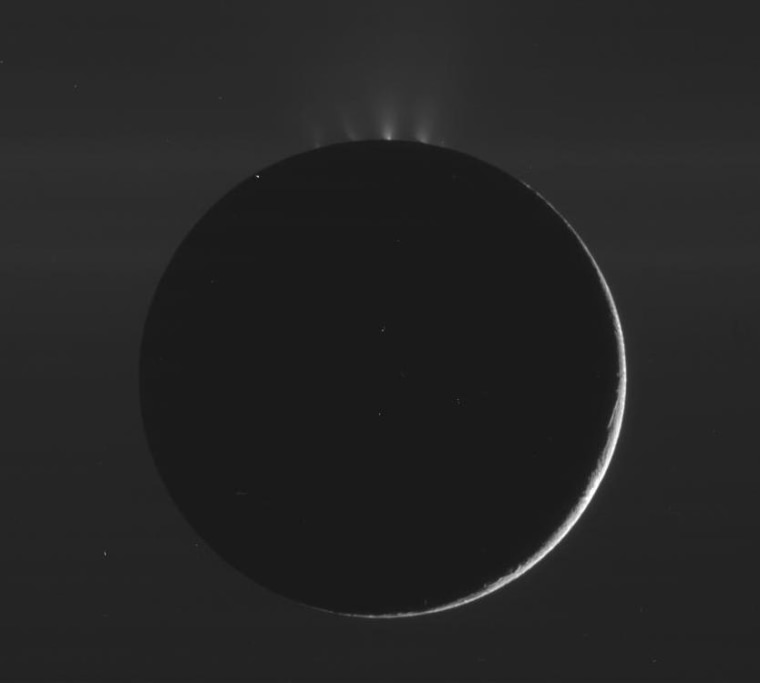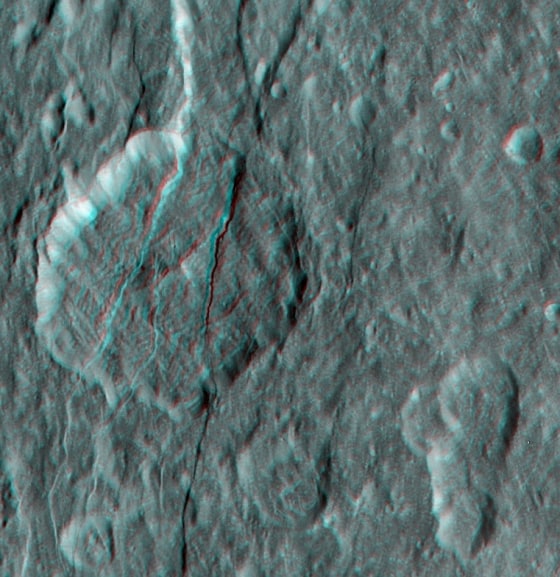
Pictures from Rhea reveal the composition and structure of the icy Saturnian moon in festive colors of green, blue and 3-D red. They're a holiday gift from the scientists who work with the imagery beamed back to Earth by the Cassini orbiter.
"In celebration of the holidays, and to mark the end of another fabulous year in orbit around Saturn, the Cassini imaging team is releasing today some very high-resolution views of Saturn's moon Rhea, including a 3-D look at a tectonically fractured region showing cracks as deep as 2.5 miles," the imaging team's leader, Carolyn Porco of the Colorado-based Space Science Institute, said in an e-mail sent out today.
The team also put out a fresh batch of raw imagery acquired during Monday's flyby of Enceladus, another one of Saturn's icy moons. Enceladus has geysers of water ice spewing from fissures in its surface, and the latest pictures take advantage of backlighting from the sun to highlight the fountains rising into space.

This week's flyby brought Cassini within 50 kilometers (31 miles) of Enceladus' surface. One particularly intriguing picture shows a dark view of the moon's rippled terrain, with those enigmatic fountains just over the horizon. The raw picture is covered with bright speckles, presumably due to radiation effects.
Cassini has produced plenty of pictures showing those rising columns of ice particles. Last month, Porco and her colleagues reported that a "phenomenal amount of heat" was emanating from the fissures as well. Such findings support the view that water or slush is being pushed up from below, most likely due to the moon's tidal flexing. If there's water and warmth beneath the surface, could there be life as well? That's a huge question that will have to be left for future space missions.
Saturn's moons in context
Meanwhile, astronomers are trying to put Saturn's various moons in their proper context. That's where the pictures of Rhea, taken during flybys in November of last year and March of this year, are coming in handy.
"Since NASA's Voyager mission visited Saturn, scientists have thought of Rhea and Dione as close cousins, with some differences in size and density," Cornell's Paul Helfenstein, an imaging team associate, said in today's image advisory. "The new images show us they're more like fraternal twins, where the resemblance is more than skin-deep. This probably comes from their nearness to each other in orbit."
A false-color image traces subtle variations in Rhea's reflectiveness, using shades of green and blue. One side of the moon always faces Saturn, and that's the side shown in the image released today (and displayed at the top of this item). The left half of the visible disk is the part that faces in the direction of Rhea's orbital motion around the planet, and the right half trails behind. Scientists believe the differences in surface appearance, seen so graphically in the false-color view, could be caused by meteoric debris slamming into one side of the moon as it moves in its orbit. Or it could be due to "magnetic sweeping," a process that occurs when ions trapped in Saturn's magnetic field strike Rhea's surface.
Scientists were hoping to find evidence of a wispy ring surrounding Rhea during the flybys, which came as close as 62 miles (100 kilometers). They had no such luck, but they did see a web of bright, wispy fractures that are similar to those spotted on a different area of the moon by the Voyager probes in 1980 and 1981.
Those wisps turn out to be exposures of bright ice along steep cliff walls, most likely formed by tectonic activity. Some of the imagery collected last year was processed to produce a high-resolution 3-D image, showing fractures and troughs cutting through two of the largest craters in the scene. Those craters have few smaller craters superimposed on top of them, suggesting that they're relatively young. That would imply that Rhea's tectonic stresses have been active relatively recently, at least in some areas.

Cassini's science team members have used the imagery to improve their mapsofRhea — and still better maps are on the way.
"The 11th of January 2011 will be especially exciting, when Cassini flies just 76 kilometers (47 miles) above the surface of Rhea," Thomas Roatsch, an imaging team scientist based at the German Aerospace Center Institute of Planetary Research, said in the advisory. "These will be by far the best images we've ever had of Rhea's surface — details down to just a few meters will become recognizable."
More about Saturn's moons and the Cassini mission:
- Oxygen. CO2 found in Rhea's wispy atmosphere
- Space walnut created by moons crashing
- Possible ice volcano spied on Titan
- Slideshow: Cassini's greatest hits
Connect with the Cosmic Log community by hitting the "like" button on the Cosmic Log Facebook page or following msnbc.com's science editor, Alan Boyle, on Twitter (@b0yle).
